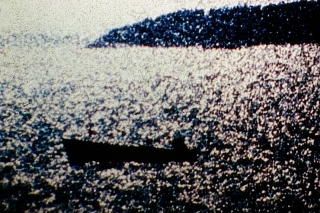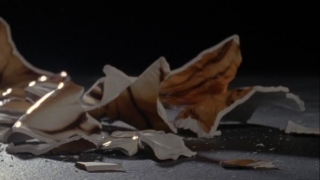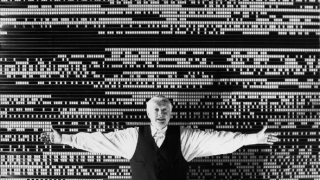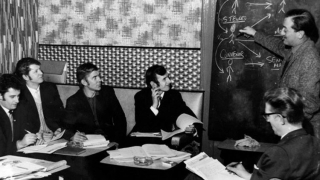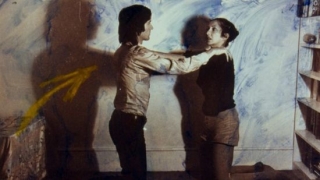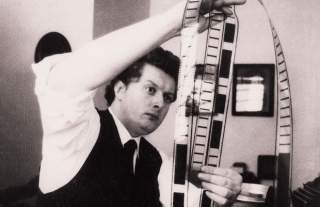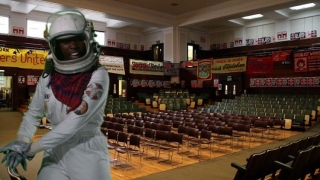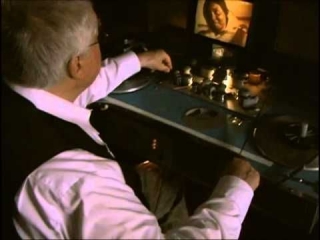Date: 27 October 2011 | Season: London Film Festival 2011, Phil Solomon | Tags: London Film Festival
PHIL SOLOMON: PROGRAMME 2
Thursday 27 October 2011, at 7pm
London Tate Modern
WHAT’S OUT TONIGHT IS LOST
Phil Solomon, 1983, 16mm, colour, silent, 8 min
“Adopting its title from a poem by Edna St. Vincent Millay, What’s Out Tonight Is Lost is an elegiac film sifting through the unrecoverable. The film is a reflecting pool where vision breaks up. The home we recognize is swallowed in the brume, the light barely penetrates; and the yellow school bus steals us away, delivering us into new clouds, embracing fear. The film has a surface of cracked porcelain and intaglio: the allergic childhood skin of cracks and bruises. This is a film of transubstantiations, the discorporation of human forms into embers. Air looms and blossoms into solidity and nearness … I hear it breathing …” (Mark McElhatten)
PSALM I: “THE LATENESS OF THE HOUR”
Phil Solomon, 2001, 16mm, colour, sound, 10 min
“A little Nachtmusik, a deep blue overture to the series. Breathing in the cool night airs, breathing out a children’s song; then whispering a prayer for a night of easeful sleep. My blue attempt at a sequel to Rose Hobart.” (Phil Solomon)
NOCTURNE
Phil Solomon, 1980, 16mm, b/w, silent, 10 min
“Its setting is a suburban neighbourhood populated by kids at play and indistinct but ominous parental figures. A submerged narrative rehearses a type of young boy’s night-time game in which a flashlight is wielded in a darkened room to produce effects of aerial combat and bombardment. A sense of hostility tinged with terror seeps into commonplace movements … Fantasy merges with nightmare, a war of dimly suppressed emotions rages beneath a veneer of household calm … In Nocturne, found footage is worked so subtly into the fabric of threat that its comes as a shock ploughed from the unconscious.” (Paul Arthur)
SEASONS …
Phil Solomon & Stan Brakhage, 2002, 16mm, colour, silent, 15 min
“Brakhage’s frame by frame hand carvings and etchings directly into the film emulsion, sometimes combined with paint, are illuminated by Solomon’s optical printing, then edited by Solomon into a four part seasonal cycle‚. This film can be considered to be part of a larger work by Brakhage entitled “…”. Seasons… is inspired by the colours and textures found in the woodcuts of Hokusai and Hiroshige, and the playful sense of forms dancing in space from the filmworks of Robert Breer and Len Lye.” (Phil Solomon)
REMAINS TO BE SEEN
Phil Solomon, 1989/94, 16mm, colour, sound, 17 min
“In the melancholic Remains to Be Seen, dedicated to the memory of Solomon’s mother, the scratchy rhythm of a respirator intones menace. The film, optically crisscrossed with tiny eggshell cracks, often seems on the verge of shattering. The passage from life into death is chartered by fugitive images: pans of an operating room, an old home movie of a picnic, a bicyclist in vague outline against burnt orange and blue … Solomon measures emotions with images that seem stolen from a family album of collective memory.” (Manohla Dargis, Village Voice)
Back to top
Date: 2 November 2011 | Season: Plenty | Tags: Peter Kubelka
PLENTY 12: DICHTUNG UND WAHRHEIT
Tuesday 2 November 2011, at 7pm
London E:vent Gallery
The screening series PLENTY proposes a new way of looking at artists’ films by showing only a single work, regardless of its duration. Each film is given the freedom to unfold on its own terms, and the viewer is given the time and space to consider it.
DICHTUNG UND WAHRHEIT (POETRY AND TRUTH)
Peter Kubelka, Austria, 2003, 16mm, colour, silent, 13 min
In cinema, as in anthropological study, the ready-made reveal ssome of the fundamental poetry and truth of our lives. Peter Kubelka unearthed sequences of discarded takes from advertising films and presents them, almost untouched, as documents that unwittingly offer valuable and humorous insights into the human condition.
“Peter Kubelka is the world’s greatest filmmaker – which is to say, simply: see his films! … by all means/above all else … et cetera.” (Stan Brakhage)
Peter Kubelka (born 1933) is an artist, anthropologist, cook and teacher. Active as a filmmaker over five decades, his total output amounts to some sixty-two minutes of screen time in which he explores the essential qualities of cinema.
PLENTY, a free monthly screening series selected by Mark Webber, forms part of the “Brief Habits” programme curated by Shama Khanna.
Date: 24 May 2012 | Season: Little Stabs at Happiness
LITTLE STABS AT HAPPINESS
LUX/ICA BIENNIAL OF MOVING IMAGES
Thursday 24 May 2012, at 8pm
London ICA Theatre
A revival of Little Stabs at Happiness, the music and film club presented by Mark Webber at the ICA from 1997 to 2000. Early evening experimental films and contemporary music will be followed by a rare screening of Roberto Rossellini’s The Machine that Kills Bad People (La Macchina ammazzacattivi). When the credits roll, the volume rises, as original Little Stabs DJs and special guests spin disco anthems, new wave big beats and smash hits of yesteryear.
8pm: Quiet Music & Underground Films
Irm & Ed Sommer, Nitsch, 1969, 16mm, 14 min
Tony & Beverly Conrad, Straight and Narrow, 1970, 16mm, 10 min
Manuel De Landa, Incontinence: A Diarrhetic Flow of Mismatches, 1978, 16mm, 18 min
9.30pm: Feature Film
Roberto Rossellini, The Machine that Kills Bad People (La Macchina ammazzacattivi), 1952, 16mm, 83 min
In Rossellini’s satirical comedy, a photographer uses a magic camera to avenge corruption and greed.
11pm: Music & Dancing
Real songs with a beat you can dance to.
1am: Close
Date: 10 October 2012 | Season: London Film Festival 2012 | Tags: London Film Festival
THE BFI 56th LONDON FILM FESTIVAL
Wednesday 10 – Sunday 21 October 2012
London BFI Southbank & ICA Cinema
This year’s London Film Festival presents its largest ever series of artists moving image programmes, culminating in the annual Experimenta Weekend from 19-21 October 2012.
In collaboration with the ICA, the Festival will also present several screenings of artists’ films to coincide with the Frieze Art Fair, from 10-13 October 2012. Our alternative opening night programme features the latest long-form work by Turner Award nominee Luke Fowler and a portrait of artist Carolee Schneemann. Further programmes at the ICA include the launch of our focus on special guest Peter Kubelka.
From his earliest film, Kubelka recognised that cinema could be so much more than a medium for telling stories, and he has been one of the most tireless advocates of film as an art form. His new work Antiphon (2012) will screen with Arnulf Rainer (1960) in an expanded projection event Monument Film on Sunday 21 October. Both films will also be exhibited on the walls of the BFI Southbank Atrium for the duration of the Festival. Martina Kudlacek’s epic documentary on Kubelka will screen at the ICA, along with a programme of his complete works to date.
The extraordinary presentation of Monument Film in the grand NFT1 cinema forms the centrepiece of an Experimenta Weekend full of outstanding visions. Thom Andersen, Nathaniel Dorsky and Laida Lertxundi return with new films, whilst Mati Diop introduces her award winning work in London for the first time, and Beatrice Gibson premieres The Tiger’s Mind.
The weekend begins appropriately at zero point, with Isidore Isou’s On Venom and Eternity (the unabridged 1951 version, screening in a brand new print): a film that radically rejected convention in its attempt to liberate cinema from the industry.
Date: 10 October 2012 | Season: London Film Festival 2012 | Tags: London Film Festival, Peter Kubelka
MONUMENT FILM INSTALLATION
Wednesday 10 – Sunday 21 October 2012
London BFI Southbank Atrium
Peter Kubelka, Monument Film, Austria, 2012, film installation
Kubelka first presented film as a three dimensional sculptural object in 1958. As an integral part of his new work Monument Film, the celluloid filmstrips of Arnulf Rainer (1960) and Antiphon (2012) will be exhibited on the walls of the Atrium at BFI Southbank, making manifest the relationship between space, time, and the physical material which runs through the projector.
Admission Free. Open from 12pm to 9pm daily.
Date: 10 October 2012 | Season: London Film Festival 2012 | Tags: London Film Festival
THE POOR STOCKINGER, THE LUDDITE CROPPER AND THE DELUDED FOLLOWERS OF JOANNA SOUTHCOTT
Wednesday 10 October 2012, at 6pm
London ICA Cinema 1
Luke Fowler, The Poor Stockinger, the Luddite Cropper and the Deluded Followers of Joanna Southcott, UK, 2012, 61 min
The new work by Luke Fowler, a current nominee for the Turner Prize, explores the role played by left wing intellectuals in the working class communities of post-war Yorkshire. At night schools organised by the Workers’ Educational Association, adults with no other access to further education were taught by progressive thinkers such as Raymond Williams, Richard Hoggart and E.P. Thompson, from whose treatise The Making of the English Working Class the film takes its long-winded title. As in previous studies of R.D. Laing and Cornelius Cardew, Fowler makes effective use of archival and contemporary materials. The result is far from a conventional documentary: in place of objective commentary, the soundtrack features the lilting voice of artist Cerith Wyn Evans reading Thompson’s class reports (pointed and often droll). For the present-day images of municipal buildings, West Riding towns and surrounding landscapes, Fowler shot in collaboration with American independent filmmaker Peter Hutton. (Mark Webber)
The screening on 10 October will feature an extended introduction by Dr Tom Steele.
Also Screening: Sunday 21 October 2012, at 4pm, BFI Southbank NFT 3
PROGRAMME NOTES
THE POOR STOCKINGER, THE LUDDITE CROPPER AND THE DELUDED FOLLOWERS OF JOANNA SOUTHCOTT
Wednesday 10 October 2012, at 6pm
London ICA Cinema 1
THE POOR STOCKINGER, THE LUDDITE CROPPER AND THE DELUDED FOLLOWERS OF JOANNA SOUTHCOTT
Luke Fowler, UK, 2012, video, colour, sound, 61 min
The Poor Stockinger, the Luddite Cropper and the Deluded Followers of Joanna Southcott focuses on the work of the Marxist historian Edward Palmer-Thompson, who, from 1946 (at the age of 24), was employed by the Workers’ Education Association (WEA) to teach literature and social history to adults in the industrial towns of the West Riding. These classes provided education to people who had been historically unable to access a university education. E.P. Thompson became synonymous with the discipline of ‘cultural studies’ that emerged in Post-War Britain, along with fellow northern socialists Raymond Williams and Richard Hoggart.
Fowler’s film explores the issues that were at stake for progressive educationalists. Like E.P. Thompson, many desired to use their teaching to create ‘revolutionaries’ and pursue the original WEA values of delivering a ‘socially purposeful’ education. The film captures a moment of optimism, in which E.P. Thompson’s ideas for progressive education came together with those of the West Riding and its existing tradition of political resistance and activism.
The film draws together archival material from television, the University of Leeds Department of Extra-Mural Studies and the Workers’ Education Association. These archival documents are set against present-day film footage and sounds gathered on location in the former West Riding region of Yorkshire.
In realising this new commission, Fowler has worked in collaboration with acclaimed American independent filmmaker Peter Hutton and Yorkshire-born writer/filmmaker George Clark. The film was first exhibited at The Hepworth Wakefield in Summer 2012 before touring to Wolverhampton Art Gallery.
Commissioned by The Hepworth Wakefield, Wolverhampton Art Gallery, and Film and Video Umbrella, through the Contemporary Art Society Annual Award for Museums: commission to collect. Supported by Arts Council England. Special thanks to the Yorkshire Film Archive.
The screening on 10 October 2012 will be introduced by Dr. Tom Steele, Senior Honorary Research Fellow at the University of Glasgow. From 1973-1987, he was a Tutor Organiser for the WEA in Leeds. His latest book, with Richard Taylor, is “British Labour and Higher Education 1945 to 2000: Ideology, Policy and Practice” (Continuum Publishing, 2010).
Back to top
Date: 10 October 2012 | Season: London Film Festival 2012 | Tags: London Film Festival
BREAKING THE FRAME
Wednesday 10 October 2012, at 8pm
London ICA Cinema 1
Marielle Nitoslawska, Breaking the Frame, Canada, 2012, 100 min
Breaking the Frame is the first feature-length documentary on Carolee Schneemann, an artist whose pioneering work has transformed discourses on the body, sexuality and gender. In cinema history, she is primarily known for Fuses, an honestly explicit film of lovemaking from a feminine viewpoint shot between 1964-67. For decades, Schneemann has similarly challenged taboos in other media, making paintings, performances, video, collage and installations in which personal experiences are absolutely entwined with formal considerations: ‘Form is emotion. I work towards metaphors of sensation, a dramatization of loss and recovery.’ Her kinetic performance style, developed while a key member of the Judson Dance Theater, produced pieces such as Meat Joy, Up To And Including Her Limits and Interior Scroll, now regarded as seminal works of live art. In this mesmerising film, which forgoes chronological biography, the artist generously shares her memories and extraordinary personal archive. Mark Webber.
Also Screening: Friday 19 October 2012, at 9pm, BFI Southbank NFT 3
PROGRAMME NOTES
BREAKING THE FRAME
Wednesday 10 October 2012, at 8pm
London ICA Cinema 1
BREAKING THE FRAME
Marielle Nitoslawska, Canada, 2012, HD video, colour, sound, 100 min
Breaking the Frame is a comprehensive portrait of the ground-breaking multidisciplinary artist Carolee Schneemann. A central figure in twentieth century avant-garde movements, Schneemann expanded the definition of art and art practice to include discourses on the body, sexuality and gender. A pioneer of performance art, she is also an accomplished painter, poet, installation artist and filmmaker.
Giving Schneemann space to tell her own story and share her thoughts, recollections and mediations on her life and work, Nitoslawska traces an intimate course though the artist’s iconic oeuvre. The film demonstrates the diversity of her enormous artistic achievement and opens the work to renewed contemplation. A critical meditation on the relation of art to the physical, domestic and conceptual aspects of daily life as well as the structure and attributes of memory, Breaking the Frame itself pushes the formal boundaries of documentary filmmaking.
Eschewing standard chronologies, the film couples descriptive and self-reflexive modalities as it interweaves aesthetic and political reflection on the feminist body as a site for reframing art’s histories. Deftly weaving archival images with contemporary footage of Schneemann’s journals, paintings and rural home, Nitoslawska captures the multi-dimensionality of the artist’s work. By highlighting the sheen of photographic prints, the fibres of diary pages and the gloss of wet paint, she provides a textured mise-en-scene that resonates with Schneemann’s corporeal focus. The visual composition of the film is complemented by a soundtrack replete with the music of James Tenney. The late composer was Schneemann’s companion and collaborator for many years, and the two remained close friends until his death in 2006.
(Images Festival)
I first saw Schneemann’s Fuses in my early twenties. While researching my film Bad Girl, I began dreaming up a sequel of sorts, with a focus on Schneemann. We met while she was renting a Montréal studio and discussed a possible film. When I visited her in New York, I knew it would happen. Her house, garden and pond were innately cinematographic in the setting sun and rising magic hour. I began digging into her well of archives, realizing it perhaps has no bottom. So began Breaking The Frame. The greatest asset of independent filmmaking is time. This process lasts years; a way of working that isn’t practical but yields irreplaceable authenticity. You observe, collect and wonder how to evoke the ‘past’ in the flow of cinema’s ever-virtual ‘present’. You displace space and fragment time. You listen. You follow the mind’s eye.
(Marielle Nitoslawska)
Back to top
Date: 11 October 2012 | Season: London Film Festival 2012 | Tags: London Film Festival, Peter Kubelka
PETER KUBELKA: THE ESSENCE OF CINEMA
Thursday 11 October 2012, at 6pm
London ICA Cinema 1
The seven films made by Peter Kubelka between 1955 and 2003 are an extraordinary demonstration of cinematic possibilities. In the ‘metric’ films Adebar, Schwechater and Arnulf Rainer, each individual element is precisely placed in relation to each other and the whole, resulting in a rhythmic viewing experience that articulates his assertion that ‘film is not movement’. The ‘metaphoric’ works Mosaik im Vertrauen, Unsere Afrikareise, Pause! and Dichtung und Wahrheit explore ways in which meaning can be constructed by the juxtaposition of images and sound. Astounding at first sight, our understanding of these films deepens with repeated viewings.
‘Kubelka’s cinema is like a piece of crystal, or some other object of nature: It doesn’t look like it was produced by man; one could easily conceive that it was picked up from among the organic treasures of nature.’ (Jonas Mekas)
Peter Kubelka, Mosaik im Vertrauen, 1955, 17 min
Peter Kubelka, Adebar, Austria, 1957, 2 min
Peter Kubelka, Schwechater, Austria, 1958, 1 min
Peter Kubelka, Arnulf Rainer, Austria, 1960, 6 min
Peter Kubelka, Unsere Afrikareise, Austria, 1966, 13 min
Peter Kubelka, Pause!, Austria, 1977, 12 min
Peter Kubelka, Dichtung und Wahrheit, Austria, 2003, 13 min
Peter Kubelka will present his new work Monument Film at BFI Southbank on Sunday 21 October at 2pm. The Monument Film installation is on display at BFI Southbank for the duration of the Festival. Martina Kudlácek’s documentary Fragments of Kubelka screens at the ICA on Saturday 13 October at 1pm.
PROGRAMME NOTES
PETER KUBELKA: THE ESSENCE OF CINEMA
Thursday 11 October 2012, at 6pm
London ICA Cinema 1
MOSAIK IM VERTRAUEN
Peter Kubelka, Austria, 1955, 35mm, b/w & colour, sound, 17 min
Kubelka’s motives for making the film lie in his belief that commercial films do not fully exploit cinematic possibilities. He declares that the place of the plot and its ostensibly disparate scenes is the screen, and the time shall be any time at which the film is shown. (Alfred Schmeller)
ADEBAR
Peter Kubelka, Austria, 1957, 35mm, b/w, sound, 2 min
Here, at last, is a filmmaker’s ear that creates in contrapuntal accord with his eye in the making. If the projection of Adebar is perfectly synced, the experience is an indescribably new one for any with eyes and ears to see/hear it. (Stan Brakhage)
SCHWECHATER
Peter Kubelka, Austria, 1958, 35mm, b/w & colour, sound, 1 min
Kubelka’s achievement is that he has taken Soviet montage one step further. While Eisenstein used shots as the basic units and edited them together in a pattern to make meanings, Kubelka has gone back to the individual still frame as the essence of cinema. (Fred Camper)
ARNULF RAINER
Peter Kubelka, Austria, 1960, 35mm, b/w, sound, 6 min
Arnulf Rainer is an architecture built in time by cinema. It uses only the four essential elements of the medium: light, darkness, sound and silence. (Peter Kubelka)
UNSERE AFRIKAREISE
Peter Kubelka, Austria, 1966, 16mm, colour, sound, 13 min
Unsere Afrikareise is about the richest, most articulate, and most compressed film I have ever seen. Kubelka’s film is one of the cinema’s few masterpieces and a work of such great perfection that it forces one to re-evaluate everything that one knew about cinema. The incredible artistry of this man, his incredible patience, his methods of working, and the beauty of his accomplishment, makes the rest of us look like amateurs. (Jonas Mekas)
PAUSE!
Peter Kubelka, Austria, 1977, 16mm, colour, sound, 12 min
Arnulf Rainer’s face art, which constitutes the source of imagery of Pause!, is a chapter of modern art in itself. Kubelka had to consume and to transcend not only Arnulf Rainer but also to transcend the entire genre of contemporary art known as face art. Both Rainer and Art disintegrated and became molecules, frames of movement and expression, material at the disposal of the Muse of Cinema. Pause! is an ecstatic work. (Jonas Mekas)
DICHTUNG UND WAHRHEIT
Peter Kubelka, Austria, 2003, 35mm, colour, silent, 13 min
Dichtung und Wahrheit features 12 stories; 12 sequences, each composed of one shot that is repeated in three, or five, or a dozen variations. Each take captures a movement from a stasis to motion and back again. For Kubelka, the repetition of physical movement – as in dance, as in film, as in life – is the fundamental law of the universe, from which even civilization’s most complex systems derive. (Alexander Horwath)
Back to top
Date: 11 October 2012 | Season: London Film Festival 2012 | Tags: London Film Festival
OCCUPY THE CINEMA
Thursday 11 October 2012, at 8pm
London ICA Cinema 1
Ben Russell & Guillaume Cailleau, Austerity Measures, Greece, 2012, 9 min
Athens at crisis point: a colour-separation portrait of the Exarchia neighbourhood during the anti-austerity protests.
Ken Jacobs, Seeking the Monkey King, USA, 2011, 40 min
Amid the hypnotic, flickering motion of a metallic terrain, vitriolic onscreen texts rail against American culpability, from the Revolution to Iraq to the present administration. Each statement casts an arrow, and J.G. Thirlwell’s monstrously cinematic score drives them home.
Brad Butler & Karen Mirza, Deep State, UK, 2012, 44 min
‘An audacious, semi-fantastical secret history of the counterforces of popular protest and clandestine control, this struggle is told through archive material, contemporary footage and future speculation.’
A direct development of the filmmakers’ visit to Cairo prior to the Tahrir Square uprising, Deep State was commissioned by Film & Video Umbrella, and made in collaboration with author China Miéville.
PROGRAMME NOTES
OCCUPY THE CINEMA
Thursday 11 October 2012, at 8pm
London ICA Cinema 1
AUSTERITY MEASURES
Ben Russell & Guillaume Cailleau, Greece, 2012, 16mm, colour, silent, 9 min
A colour-separation portrait of the Exarchia neighbourhood of Athens, Greece, made during the Anti-Austerity protests in late 2011. In a place thick with stray cats and scooters, cops and Molotovs, ancient myths and new ruins; where fists are raised like so many columns in the Parthenon, this is a film of surfaces – of grafitti’d marble streets and wheat-pasted city walls – hand-processed in red, green, and blue. Made as part of a hand-processing workshop at LabA in Athens. (Ben Russell)
www.dimeshow.com
SEEKING THE MONKEY KING
Ken Jacobs, USA, 2011, HD video, colour, sound, 40 min
The film could have well been called ‘Kicking and Screaming’ but that only describes me in the process of making it, questioning its taste. Once the message kicked in it overrode all objection. The piece demanded J.G. Thirlwell’s music, normally way too overtly expressive for me as most of my stuff comes out of painting and is also to be absorbed in silence. Who will even notice visual innovation now, or what’s happening with time? Determining a place between two and three dimensions, pushing time to take on substance, is what I do. Seeking the Monkey King is a reversion to my mid-twenties and that sense of horror that drove the making of Star Spangled to Death. (Ken Jacobs)
DEEP STATE
Brad Butler & Karen Mirza, UK, 2012, HD video, colour, sound, 44 min
The film takes its title from the Turkish term ‘Derin Devlet’, meaning ‘state within the state’. Although its existence is impossible to verify, this shadowy nexus of special interests and covert relationships is the place where real power is said to reside, and where fundamental decisions are made – decisions that often run counter to the outward impression of democracy. Amorphous and unseen, the influence of this deep state is glimpsed at regular points throughout the film – most clearly surfacing in its reflexive responses to popular protest, and in legislated acts of violence and containment, but also rumbling and reverberating, deeper down, in an eternally recurring call-and-response between rhetorical positions and counter-languages, in which a raised fist, a thrown rock, a crowd surge, an occupation, provoke a corresponding reaction in the form of a police charge, a baton attack, a pepper spray, assassinations. A powerful undertow in the ongoing tide of history, this push and pull of competing forces is deftly illuminated in a vivid montage of newly filmed and archive footage. Collided together, past, present and future trace a continuum in which the same repetitive patterns are played out. Against a backdrop of momentous, historically resonant demonstrations, an eternal rioter, or ‘riotonaut’, is picked out, as if by a searchlight, ever-present at each and every flashpoint. On a moonscape, confronted with a picket that becomes a riot, an ur-dictator, the personification of the ‘Deep State’, blurts stupefying, hot-air abstractions of neo-liberalism. Deep State is a film by Karen Mirza and Brad Butler that has been scripted in collaboration with author China Miéville. Commissioned by Film and Video Umbrella. Funded by Arts Council England and London Councils. (Karen Mirza & Brad Butler)
www.mirza-butler.net
Back to top
Date: 13 October 2012 | Season: London Film Festival 2012 | Tags: London Film Festival, Peter Kubelka
FRAGMENTS OF KUBELKA
Saturday 13 October 2012, at 1pm
London ICA Cinema 1
Martina Kudlácek, Fragments of Kubelka, Austria, 2012, 232 min
In this extended portrait, Peter Kubelka speaks at length about his life, work and interests, drawing on a vast range of knowledge and experience. Active as a filmmaker since the 1950s, Kubelka’s acclaimed cinematic works are only one aspect of his dynamic personality. In his legendary public lectures, he holds forth on a variety of disciplines including film, music, archaeology and cooking. He has also played an important institutional role in establishing the Austrian Film Museum, and as co-founder of Anthology Film Archives, for whom he designed an ideal viewing theatre known as the Invisible Cinema. Martina Kudlácek (known for previous documentaries on Maya Deren and Marie Menken) immersed herself in Kubelka’s world for several years, researching historical footage, recording lectures, and perhaps most importantly, filming him at home surrounded by his eclectic collection of anthropological objects. In these precious sequences, Fragments of Kubelka provides extraordinary insight in conveying his philosophy on life and art.
PROGRAMME NOTES
FRAGMENTS OF KUBELKA
Saturday 13 October 2012, at 1pm
London ICA Cinema 1
FRAGMENTS OF KUBELKA
Martina Kudlácek, Austria, 2012, HD video, colour, sound, 232 min
Fragments of Kubelka is an epic documentary subtly introduces the complex worldview of iconic filmmaker and theoretician Peter Kubelka (born 1934, Vienna). While Kubelka’s radical and pioneering body of films is a highly condensed work of about an hour, focusing on the essence of cinema, his legendary lectures often unfold over many hours. These lectures on ‘what is cinema’ and ‘cooking as an art form’ are frequently illuminated by presentation of archaeological artefacts from Kubelka’s eclectic collection. He considers his ongoing collecting to be an expanded film practice which explores the evolution of humanity. Martina Kudlácek has carefully woven an open-ended portrait which goes beyond the biographical to reveal fresh insights into the phenomenon of film.
The filmmaker Jonas Mekas has written: ‘Kubelka’s cinema is like a piece of crystal, or some other object of nature: It doesn´t look like it was produced by man; one could easily conceive that it was picked up from among the organic treasures of nature.’
Back to top
